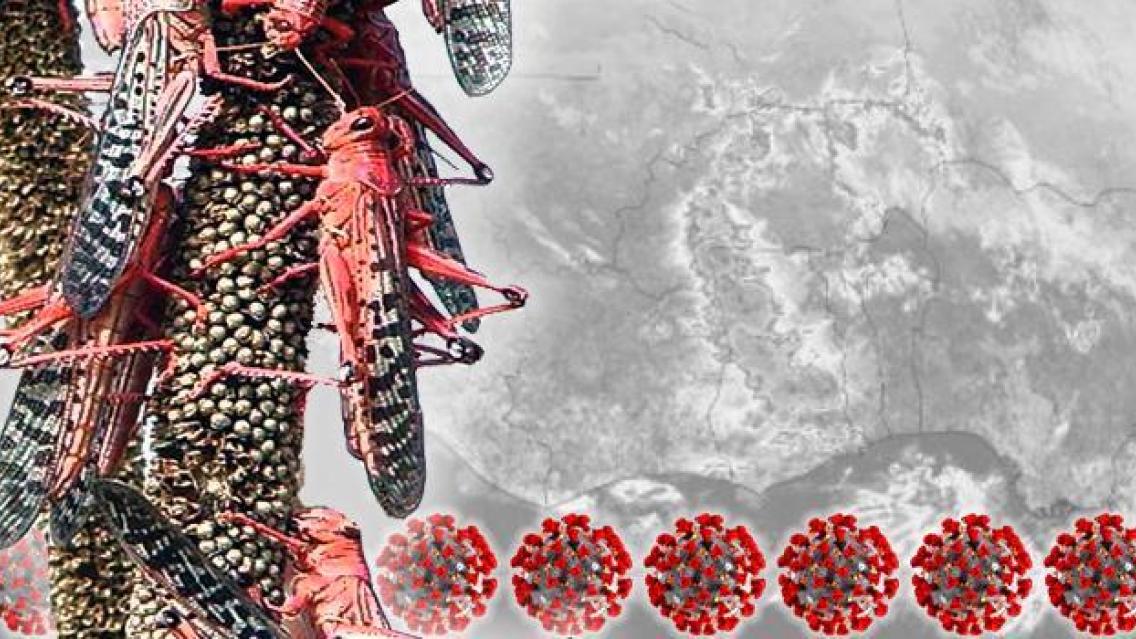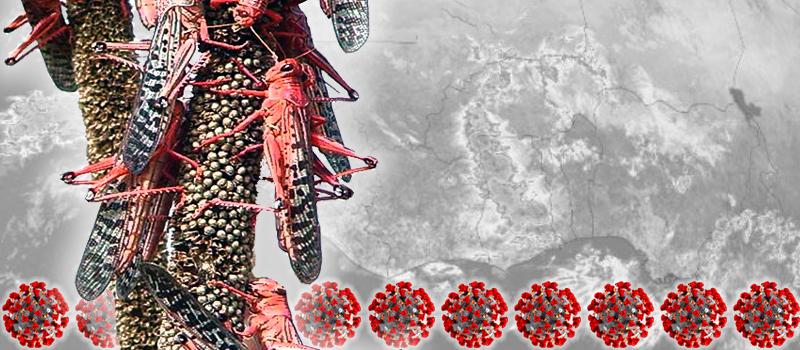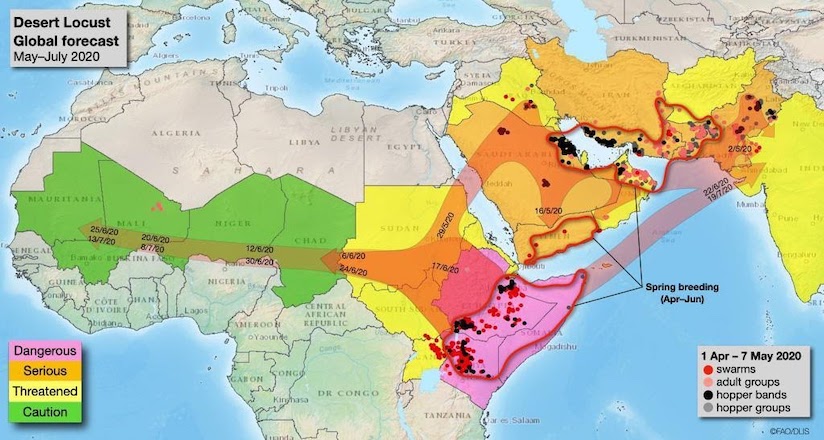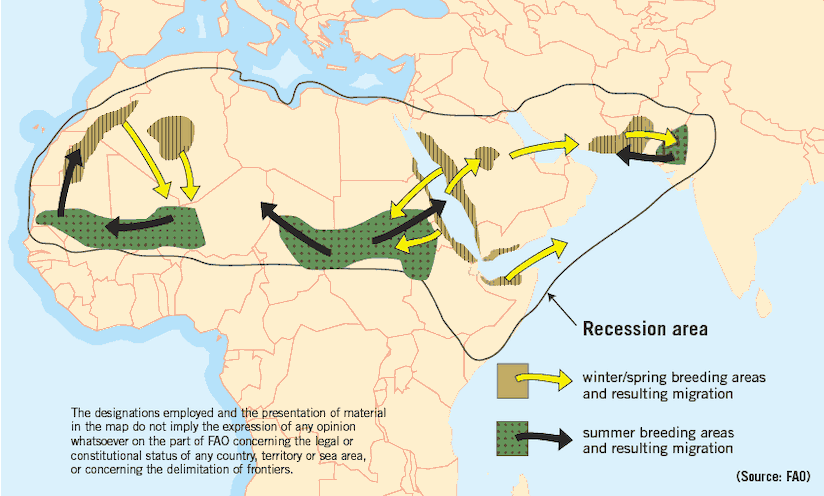Tracking the Perfect Storm in West Africa: COVID-19 and Desert Locusts

This post was written by Idrissa Halidou Maiga (AGRHYMET/CILSS), Issoufou Baoua (AGRHYMET/CILSS), Gary Jahn (USAID/RFS) and Kiersten B. Johnson (USAID/RFS), and was originally featured on Agrilinks. Click here to go to the original blog post.

Images of gregarious locusts on millet heads and the CDC coronavirus graphic superimposed over a satellite image of West Africa
"Until a locust population reaches a certain density, they all act like any grasshoppers. When the critical point is reached, they turn savage and swarm and try to eat the world."– John D. MacDonald, Nightmare in Pink, 1964
The West Africa region has hard-won experience in managing both desert locust (Schistocerca gregaria, Forskål) outbreaks and outbreaks of serious viral epidemics like Ebola. This year, teams of experts of the Cadre Harmonise Regional Technical Committee in the Sahel and West Africa are leveraging that experience––and the latest satellite technology––to track and assess the impact of the simultaneous threats of the COVID-19 pandemic and a historic desert locust upsurge on food and nutrition security and livelihood conditions. COVID-19 continues to impact the health of populations worldwide; it is also continuing to impact agricultural production (access to land, labour and agricultural inputs); meanwhile, the desert locust upsurge is devastating crops in East Africa, the Middle East, and South Asia, while also threatening agricultural production in West Africa, in the coming months.
The COVID-19 pandemic
Severe acute respiratory syndrome coronavirus 2 (SARS-CoV-2) is the strain of coronavirus that causes coronavirus disease 2019 (COVID-19), a respiratory illness. It is a zoonotic disease that is contagious in humans, and the World Health Organization (WHO) has designated the ongoing pandemic of COVID-19 a public health emergency of international concern. The virus primarily spreads between people through close contact and via respiratory droplets produced from coughs or sneezes.
Globally, COVID-19 has impacted not only the health of populations worldwide, but it has also impacted agricultural production. Despite efforts in many countries to protect agriculture as an essential business, access to agricultural inputs (e.g. seeds, fertilizer, fodder) is hindered by import bans, severely backed-up supply chains, and lack of credit for farmers as funds are diverted to COVID-19 response. These shortages of inputs drive up their price. For example, in Ghana, the cost of agricultural inputs has doubled since the pandemic began. Planting and harvesting is delayed as migrant labor is prevented. As markets close or lockdown orders are enforced, getting produce or livestock to markets is increasingly difficult. Even where there is an adequate food supply, measures to enforce social distancing limit access to food as it spoils on farms and in warehouses.
In West Africa, the spread of COVID-19 is anticipated to financially hurt farmer cooperatives as they are unable to dispose of their seed stock which they produced with borrowed capital. Travel restrictions and stay-at-home orders will reduce available farm labor. Following harvest, farmers frequently travel to urban centers to market their crops. COVID-19-related shutdowns of public transportation, curfews, and other travel restrictions are preventing some farmers from getting to cities and others from returning home. As trade blockages reduce access to inputs, markets, and income, agricultural production will fall. According to the World Bank, agricultural production in sub-Saharan Africa could contract between 2.6-7 percent if trade blockages persist. Food imports could decline 13-25 percent. Even before the pandemic, 30 million people in West Africa’s Sahel region struggled to find sufficient food. According to the World Food Program, more than 43 million people in West Africa will be in urgent need of food assistance in the coming months as COVID-19 and ongoing conflicts take their toll on agricultural workers and shut down food supply chains. The situation may get even worse if desert locust swarms arrive this summer.

Figure 1: Overview of the origins of the current desert locust upsurge; note the cyclones in 2018 and 2019 that created
the conditions favorable to the currently observed desert locust outbreaks. (Image courtesy of FAO Locust Watch)
The desert locust plague
In 2018 and 2019, cyclones brought extensive rains to the Arabian Peninsula, ending a drought and creating patches of vegetation that ultimately led to the formation of desert locust swarms (Figure 1). These large swarms moved across the Red Sea to Ethiopia and Somalia by June 2019. Aided by heavy winds and rains, the locusts spread to Kenya, Uganda, and Tanzania from October to December 2019. This is the worst locust plague in 25 years for Ethiopia and in 70 years for Kenya. According to the United Nations (UN) Food and Agriculture Organization (FAO), as of mid-April 2020, desert locusts in Ethiopia alone consumed 356,000 tons of cereal and affected 1.3 million hectares of pastureland. Across 10 countries, FAO estimates that locust control efforts have saved over 720,000 tons of crops so far, but they also forecast another wave of new locust swarms in June and July of this year.
Locust swarms have not yet arrived in the Sahel and West Africa. Depending on the weather, swarms from spring breeding areas in Arabia and East Africa could reach the eastern part of the Sahel in Eastern Chad starting from June if winds carry them westward before the summer rains commence (Figure 2).

Figure 2: Anticipated dispersion of current locust upsurge; courtesy of FAO Locust Watch.
FAO estimates it will need $50-75 million to control desert locusts and help 26.3 million food-insecure people, including 9.3 million who would be affected by the impact of locusts, in West Africa from June to August 2020. Therefore, it is critical that investments in preparedness and anticipatory actions are immediately implemented and quickly scaled up to face the potential threat. The FAO Western Region Commission for the Desert locust control (CLCPRO) and its country members, with the support of CILSS (the French acronym for Permanent Inter-States Committee for Drought Control in the Sahel) have set up national and regional response plans in order to contain the threat.
In particular, the next two to three weeks will be important for monitoring and preparedness activities as locusts move into summer breeding grounds in Sudan (Figure 3). If locusts arrive in Sudan before the rains, they will continue to move with prevailing winds across the Sahel, exposing a number of countries to further locust damage. Although West African authorities are preparing for a potential locust infestation, ongoing conflict dynamics and the COVID-19 pandemic may disrupt planned surveillance and control––as has occurred in countries in the Horn of Africa and on the Arabian Peninsula.

Figure 3: Locust breeding areas and migration routes; courtesy of FAO Locust Watch.
Monitoring the dual threats of COVID-19 and locusts
Ideally, the desert locusts should be controlled before they begin swarming and destroying crops and pastures. Finding the locust breeding sites has long been a challenge. The desert locusts can potentially lay eggs in semi-arid areas in Africa covering hundreds of thousands of square kilometers spread over some of the world’s most dangerous conflict zones (Figure 4).

Figure 4: Map showing desert locust breeding and invasion areas
Locusts only lay eggs in warm, moist, sandy soil. Once the eggs hatch, the immature, flightless locusts move collectively as hopper bands to patches of vegetation. Through SERVIR, USAID is supporting efforts to locate locust breeding sites. SERVIR, a joint development initiative of the National Aeronautics and Space Administration (NASA) and USAID, works with regional organizations to help developing countries use information from Earth observing satellites to manage climate risks, land use, and outbreaks of pests and diseases. Researchers at SERVIR-West Africa are perfecting ways to use NASA remote sensing observations of soil moisture and vegetation to forecast and identify locust breeding sites.
Despite the distinctive pink color of immature adult locusts and the bright yellow of sexually mature adult locusts, it is not yet possible to track the movement of locust swarms by satellite. However, it is possible to forecast swarm movements. The National Oceanic and Atmospheric Administration (NOAA), a collaborator of SERVIR, has repurposed a remote sensing tool originally designed to track wind patterns and forecast the movement of wildfire and volcanic smoke plumes to forecast the movement of locust swarms (try the HYSPLIT Locust Forecast modeling tool yourself here). Finally, the destruction of crops can also be assessed using satellite data, although it is difficult to distinguish crop losses due to locusts from other causes. If the cause of crop loss is already known to be locusts (as in the satellite photos shown in Figure 5), then the images can be used to estimate crop loss.

Figure 5: Satellite images showing known sites of desert locust damage to crops in Ethiopia.
Source: https://medium.com/soar-earth/locust-swarms-causing-devastation-horn-of-africa-3b43c9710707
The AGRHYMET (which stands for the AGRrometeorology, HYdrology, METeorology) Regional Center is a specialized institution in the Sahel mandated to train and inform on Sahelian food security, desertification, and water control. It is the host institution for SERVIR-West Africa and has worked on locust issues for many years in collaboration with CLCPRO. SERVIR-West Africa began working on a desert locust service in 2016 with an aim to strengthen both the National Desert Locust Control Units in member countries and the Desert Locust Information Service led by the FAO.
With the advent of the COVID-19 pandemic, experts of the Cadre Harmonise Technical Committee led by AGRHYMET recognized the concomitant threats of COVID-19 and locusts arriving in the region and began work to establish a tool to monitor the food and nutrition security situation. With partners (including CILSS, FAO, WFP, UNICEF, EC-JRC, GSU/IPC, FEWSNET, FICR, ACF, Oxfam, and Save the Children) and support from donors (including EU, USAID, WB, AfDB, ECOWAS, UEMOA), a technical advisory committee was established to develop a Cadre Harmonise––an integrated approach for monitoring of food and nutrition insecurity in the Sahel and West Africa. This committee has taken steps to rapidly develop a complementary routine monitoring information system that tracks both COVID-related indicators and locust-related indicators, allowing for an evolving understanding of the severity of the situation on the ground.
To carry out the monitoring, the committee has designed a matrix using Excel spreadsheets to support monitoring the COVID-19 impact and all of the health and nutrition measures put in place for each country at the national and sub-national administrative levels. Elements of the COVID-19 pandemic that are tracked include the number of infections and treatments and the functioning of health systems within each country.
Integrated into the same spreadsheet is information collected on market prices for cereals and cattle––as well as how people rate the availability of food during this time; the extent to which market demand for agricultural products (cash crops) and cattle is shifting; information on the impact on income-generating activities and pasture and biomass availability; and access to agricultural inputs including feed.
Additionally, the spreadsheet incorporates information on desert locusts: their absence, or their presence, and stages––hopper bands and swarms.
By routinely updating this spreadsheet-based monitoring system, the committee will be poised to give early warning of incipient impacts from COVID-19, locusts, or both concurrently; this allows decision makers to take informed action to head off the worst impacts of these parallel threats to agriculture and food security in the region.
Outbreaks affecting agricultural production and food security ultimately have global repercussions on trade and commerce. Going forward, satellite imagery can also tell us the economic impact of pest and disease outbreaks, and the pace of recovery, by tracking the movements of goods on a grand scale.
Earth observations not only help us to forecast, track, and respond to crises, they show us that we are all one world. West Africa is facing many challenges––but not alone.

